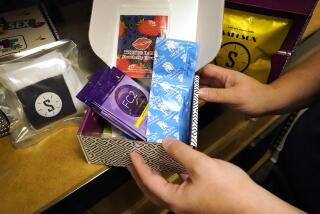Birth Control 101
Postponing sexual involvement or remaining abstinent until marriage have been the most popular sex education themes in schools and communities in recent years.
But a new study suggests that leaving information about contraceptives out of the curriculum may be a big mistake.
The study--by a researcher who, coincidentally, has been tapped by Gov. Pete Wilson to advise his office on family planning issues--may cause some discomfort among adults who believe that talking about condoms and the like encourages promiscuity.
Moreover, the findings have emerged at a time when school districts are struggling to come up with new approaches to sex education. Late last year, Wilson stunned health educators by announcing that he was dropping the state’s three-year, multimillion-dollar sex education program for 12- to 14-year-olds called Education Now and Babies Later (ENABL) because, the governor said, it had failed to reduce teen pregnancy rates.
While the new study doesn’t claim to have all the answers about what constitutes an effective sex education course, it makes a strong case for teaching detailed information about contraceptives to youths by at least age 13 or 14.
“This study is a kind of red flag,” says lead author Jane Mauldon, assistant professor of public policy at UC Berkeley. “It says, ‘Hey, folks, wake up and pay attention.’ We’ve been writing off sex education, and we should not do that. This is a strong piece of evidence that contraceptive information makes a difference.”
The work, co-written by Kristin Luker, a UC Berkeley professor of sociology, analyzed data from 1,479 American women who were unmarried teens at the time of their first sexual experience.
The survey, published recently in the journal Family Planning Perspectives, found that among the teens who received education before the first sexual encounter, 44% used a condom, 10% used the pill; 2% used another form of contraceptive; and 44% used nothing.
Among teens who had education after first sex or in the same year, 37% used condoms, 7% used the pill; 1% used another form of contraceptive; and 55% used nothing.
Among teens who had no contraceptive education, 33% used condoms, 8% used the pill; 4% used another form of contraceptive; and 55% used nothing.
Thus, having contraceptives education before first sex, the study concluded, increased the use of condoms by about one-third, a significant boost, Mauldon notes.
The use of contraceptives at first sex is considered to be important because previous studies show consistency in contraceptives use for some time afterward. Moreover, one-fifth of all first pregnancies among teens occur within the first few months after they become sexually active.
Previous research has consistently shown that receiving information about contraceptives does not hasten sexual activity. And this analysis showed that having contraceptives education may even help to postpone first sex. The group that received education first was an average of 18 months older at first sex than the females who didn’t receive education.
But the study--which included females aged 15 to 44 at the time of the 1988 survey--did not reveal anything else about the sex education curricula the women received. And Mauldon notes that the research should not be interpreted to mean the contraceptives education alone will help reduce teen pregnancy and sexually transmitted diseases.
“Contraceptives education [before first sex] makes a measurable difference. It’s not a panacea,” she says. “It should be a small part of a sex education curriculum that focuses on sexual health, appropriate decision-making and responsible choices, and dealing with emotional intimacy.”
But there appears to be little social or political support for a more comprehensive approach to sex education at the grade-school or junior high level, some observers note. Since scrapping ENABL, Wilson has instituted a multi-pronged approach to teen pregnancy prevention that focuses on educating males, a new media campaign to promote the social norm that sexual activity is inappropriate for adolescents, and developing an abstinence-only curriculum that can be shown to be effective.
Also, this year, school districts can apply for funding to institute their own teen pregnancy prevention initiatives in partnership with their communities. The state Department of Education grants are the result of legislation passed last year.
Within all these approaches, individual communities have broad freedom on whether--or at what age--to introduce adolescents to contraceptives.
Health educator Lynn Posey of the Coalition for Children, Adolescents & Parents in Orange says she doubts Mauldon’s findings will have much impact on conservative school districts. Contraceptives education, she says, “is a sensitive subject in junior highs in this state.”
“It’s too politicized and it’s controversial,” Posey says. “You are talking about values and morals, and that strikes a nerve.”
Mauldon says she regrets that her research may not be judged on its own merit.
“I don’t think this debate has been very informed by the findings of research,” she says. “It’s been driven by issues of ideology and cultural and religious matters. Effective policies for teens can be made if you de-politicize the issue and take account of the serious health and social problems facing teens. We need to put teens first and not allow this to become a larger issue about a moral breakdown in society.”
More to Read
Sign up for Essential California
The most important California stories and recommendations in your inbox every morning.
You may occasionally receive promotional content from the Los Angeles Times.









